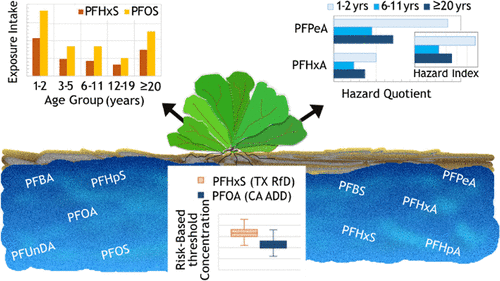当前位置:
X-MOL 学术
›
Environ. Sci. Technol.
›
论文详情
Our official English website, www.x-mol.net, welcomes your
feedback! (Note: you will need to create a separate account there.)
Assessing Human Health Risks from Per- and Polyfluoroalkyl Substance (PFAS)-Impacted Vegetable Consumption: A Tiered Modeling Approach
Environmental Science & Technology ( IF 10.8 ) Pub Date : 2020-11-17 , DOI: 10.1021/acs.est.0c03411 Juliane B. Brown 1 , Jason M. Conder 2 , Jennifer A. Arblaster 3 , Christopher P. Higgins 1
Environmental Science & Technology ( IF 10.8 ) Pub Date : 2020-11-17 , DOI: 10.1021/acs.est.0c03411 Juliane B. Brown 1 , Jason M. Conder 2 , Jennifer A. Arblaster 3 , Christopher P. Higgins 1
Affiliation

|
Irrigation water or soil contaminated with per- and polyfluoroalkyl substances (PFASs) raises concerns among regulators tasked with protecting human health from potential PFAS-contaminated food crops, with several studies identifying crop uptake as an important exposure pathway. We estimated daily dietary exposure intake of individual PFASs in vegetables for children and adults using Monte Carlo simulation in a tiered stochastic modeling approach: exposures were the highest for young children (1–2 years > adults > 3–5 years > 6–11 years > 12–19 years). Using the lowest available human health toxicity reference values (RfDs) and no additional exposure, estimated fifth percentile risk-based threshold concentrations in irrigation water were 38 ng/L (median 180 ng/L) for perfluorooctanoate (PFOA) and 140 ng/L (median 850 ng/L) for perfluorooctane sulfonate (PFOS). Thus, consumption of vegetables irrigated with PFAS-impacted water that meets the current 70 ng/L of PFOA and PFOS U.S. Environmental Protection Agency’s lifetime health advisory for drinking water may or may not be protective of vegetable exposures to these contaminants. Hazard analyses using real-world PFAS-contaminated groundwater data for a hypothetical farm showed estimated exposures to most PFASs exceeding available or derived RfDs, indicating water-to-crop transfer is an important exposure pathway for communities with PFAS-impacted irrigation water.
中文翻译:

从全氟和多氟烷基物质(PFAS)影响的蔬菜消费评估人类健康风险:分层建模方法
受全氟和多氟烷基物质(PFAS)污染的灌溉水或土壤引起了负责保护人类健康免受潜在PFAS污染的粮食作物危害的监管机构的关注,多项研究将作物吸收作为重要的暴露途径。我们使用蒙特卡洛模拟方法在分层随机建模方法中估算了儿童和成人蔬菜中全氟辛烷磺酸的日常饮食摄入量:幼儿的暴露量最高(1-2岁>成人> 3-5岁> 6-11岁> 12-19年)。使用最低的人类健康毒性参考值(RfDs),并且不增加暴露量,估计的灌溉水中基于百分位数风险的第五阈值浓度为全氟辛酸酯(PFOA)为38 ng / L(中位数180 ng / L)和全氟辛烷磺酸(PFOS)为140 ng / L(中位数850 ng / L)。因此,食用受PFAS冲击的水灌溉的蔬菜要满足当前PFOA的70 ng / L和PFOS的要求。美国环境保护署关于饮用水的终生健康建议可能会或可能不会防止蔬菜暴露于这些污染物。对一个假设农场使用现实世界中受PFAS污染的地下水数据进行的危害分析表明,估计大多数PFAS的暴露量超过了可用RfD或衍生的RfDs,这表明水到作物的转移是受PFAS影响的灌溉水社区的重要暴露途径。使用受PFAS影响的水灌溉的蔬菜的消耗量达到当前PFOA的70 ng / L和PFOS的水平。美国环境保护署关于饮用水的终生健康建议可能会或可能不会防止蔬菜暴露于这些污染物。对一个假设农场使用现实世界中受PFAS污染的地下水数据进行的危害分析表明,估计大多数PFAS的暴露量超过了可用RfD或衍生的RfDs,这表明水到作物的转移是受PFAS影响的灌溉水社区的重要暴露途径。使用受PFAS影响的水灌溉的蔬菜的消耗量达到当前PFOA的70 ng / L和PFOS的水平。美国环境保护署关于饮用水的终生健康建议可能会或可能不会防止蔬菜暴露于这些污染物。对一个假设农场使用现实世界中受PFAS污染的地下水数据进行的危害分析表明,估计大多数PFAS的暴露量超过了可用RfD或衍生的RfDs,这表明水到作物的转移是受PFAS影响的灌溉水社区的重要暴露途径。
更新日期:2020-12-01
中文翻译:

从全氟和多氟烷基物质(PFAS)影响的蔬菜消费评估人类健康风险:分层建模方法
受全氟和多氟烷基物质(PFAS)污染的灌溉水或土壤引起了负责保护人类健康免受潜在PFAS污染的粮食作物危害的监管机构的关注,多项研究将作物吸收作为重要的暴露途径。我们使用蒙特卡洛模拟方法在分层随机建模方法中估算了儿童和成人蔬菜中全氟辛烷磺酸的日常饮食摄入量:幼儿的暴露量最高(1-2岁>成人> 3-5岁> 6-11岁> 12-19年)。使用最低的人类健康毒性参考值(RfDs),并且不增加暴露量,估计的灌溉水中基于百分位数风险的第五阈值浓度为全氟辛酸酯(PFOA)为38 ng / L(中位数180 ng / L)和全氟辛烷磺酸(PFOS)为140 ng / L(中位数850 ng / L)。因此,食用受PFAS冲击的水灌溉的蔬菜要满足当前PFOA的70 ng / L和PFOS的要求。美国环境保护署关于饮用水的终生健康建议可能会或可能不会防止蔬菜暴露于这些污染物。对一个假设农场使用现实世界中受PFAS污染的地下水数据进行的危害分析表明,估计大多数PFAS的暴露量超过了可用RfD或衍生的RfDs,这表明水到作物的转移是受PFAS影响的灌溉水社区的重要暴露途径。使用受PFAS影响的水灌溉的蔬菜的消耗量达到当前PFOA的70 ng / L和PFOS的水平。美国环境保护署关于饮用水的终生健康建议可能会或可能不会防止蔬菜暴露于这些污染物。对一个假设农场使用现实世界中受PFAS污染的地下水数据进行的危害分析表明,估计大多数PFAS的暴露量超过了可用RfD或衍生的RfDs,这表明水到作物的转移是受PFAS影响的灌溉水社区的重要暴露途径。使用受PFAS影响的水灌溉的蔬菜的消耗量达到当前PFOA的70 ng / L和PFOS的水平。美国环境保护署关于饮用水的终生健康建议可能会或可能不会防止蔬菜暴露于这些污染物。对一个假设农场使用现实世界中受PFAS污染的地下水数据进行的危害分析表明,估计大多数PFAS的暴露量超过了可用RfD或衍生的RfDs,这表明水到作物的转移是受PFAS影响的灌溉水社区的重要暴露途径。











































 京公网安备 11010802027423号
京公网安备 11010802027423号